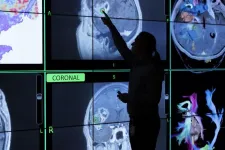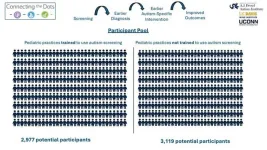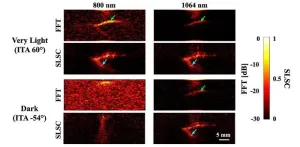(Press-News.org) A multitude of genes have been linked to the development of Alzheimer’s disease. Specifically how those genes might influence the progression of neurodegeneration remains something of a black box though, in part because of the challenges of examining in molecular detail the brain of a living patient.
Using cerebrospinal fluid (CSF) collected from living patients, a team of researchers at Washington University School of Medicine in St. Louis has for the first time linked disease-related proteins and genes to identify specific cellular pathways responsible for Alzheimer’s genesis and progression. Because these proteins were gathered from CSF, they are a good proxy for activity in the brain, and several of them may be potential targets for therapies.
The findings are available in Nature Genetics.
The use of patients’ CSF is a step forward for such studies and may be the best way to acquire relevant samples that help map out the constellation of protein activity, known as the proteome, said Carlos Cruchaga, PhD, the Barbara Burton and Reuben Morriss III professor of psychiatry and director of the NeuroGenomics and Informatics Center at WashU Medicine.
“Our goal is to identify risk-linked and protective genes, and also identify the causal role they play,” Cruchaga said. “To do that, we need to study human-derived data. That is why we decided to do a large proteomic study of cerebrospinal fluid, because we know that CSF is a good representation of the pathology of the disease.”
Cruchaga explained that similar investigations have relied on brain tissues collected postmortem, and therefore only provide information about the later stages of Alzheimer’s. Other studies have looked at blood plasma, which is not specific to the tissues affected by the disease.
In the past decade and a half of researching Alzheimer’s disease, scientists have increased the number of regions of our genome known to be associated with the condition from 10 to nearly 80. However, knowing the gene or region of DNA associated with the disease is only the first step. Linking an individual’s proteomic profile – that is, which proteins are active and to what degree – to their genetic code establishes a holistic view of the cellular activities in the brain. By comparing CSF samples from people with and without Alzheimer’s disease, the researchers could then identify which cellular pathways are dysfunctional.
“Sometimes within a region of DNA known to be associated with Alzheimer’s there are many genes, and we don’t know which of those genes are driving the medical condition,” Cruchaga said. “By adding the proteins to the analysis, we can determine the gene driving the association, determine the molecular pathway that they are part of, as well as to identify novel protein-to-protein interactions that otherwise will not be possible.”
Cruchaga and his collaborators had access to a rich database of information through the Knight-ADRC and the Dominantly Inherited Alzheimer Network (DIAN), which are based at WashU Medicine, as well as other studies through their collaborators. These studies were also able to provide the genetic information and CSF samples of 3,506 individuals, both healthy donors and those with Alzheimer’s disease.
The team cross-referenced proteomic data from the CSF samples with existing studies that had identified areas of the genome correlated with Alzheimer’s. From this process, they narrowed in on 1,883 proteins of the 6,361 in the CSF proteomic atlas. The investigators used three different established statistical analyses that can identify with high confidence genes and proteins that are part of the biological pathways leading to the disease. With this technique, they determined that 38 proteins are likely to have causal effects in Alzheimer’s progression; 15 of these can be targeted by medicines.
“The novelty and the strength of this analysis is that we have defined proteins that modify risk,” Cruchaga said. “So now that we have the causal steps, we can establish where the steps are leading to in the brain.”
The immediate implications for understanding and developing treatments for Alzheimer’s from this study are significant, but Cruchaga said he believes that CSF proteomics may yield a treasure trove of information for many neurological conditions, ranging from Parkinson’s disease to schizophrenia.
“That’s the power of this approach – once you have an atlas of genetic variants, and that of the protein levels, you can apply this to any disease,” he said.
Proteins are not the only key to unlocking these conditions to be found in the CSF. Cruchaga also is investigating the potential of metabolites – substances released by cells when breaking down other compounds as part of their routine processes that are also found in CSF. In a separate paper, also published in Nature Genetics, he and his collaborators demonstrated the promise of this approach and reported associations between specific metabolites and conditions including Parkinson’s disease, diabetes and dementia.
Western D, Timsina J, Wang L, Wang C, Yang C, Phillips B, Wang Y, Liu M, Ali M, Beric A, Gorijala P, Kohlfeld P, Budde J, Levey AI, Morris JC, Perrin RJ, Ruiz A, Marquié M, Boada M, de Rojas I, Rutledge J, Oh H, Wilson EN, Le Guen Y, Reus LM, Tijms B, Jelle Visser P, van der Lee SJ, Pijnenburg YAL, Teunissen CE, del Campo Milan M, Alvarez I, Aguilar M, Dominantly Inherited Alzheimer Network (DIAN), the Alzheimer’s Disease Neuroimaging Initiative (ADNI), Greicius MD, Pastor P, Pulford DJ, Ibanez l, Wyss-Coray T, Sung YJ, Cruchaga C. Proteogenomic analysis of human cerebrospinal fluid identifies neurologically relevant regulation and implicates causal proteins for Alzheimer’s disease Nature Genetics. Nov. 11, 2024. DOI: 10.1038/s41588-024-01972-8
Cruchaga has received research support from GSK and Eisai. The funders of the study had no role in the collection, analysis or interpretation of data; in the writing of the report; or in the decision to submit the paper for publication. Cruchaga is a member of the advisory board of Circular Genomics and owns stocks in this company.
This work was supported by grants from the National Institutes of Health (NIH), R01AG044546, P01AG00399, RF1AG053303, RF1AG058501, U01AG058922, RF1AG074007, R00AG062723, P30 AG066515, NIH P30AG066444, P01AG03991, P01AG026276 the Chan Zuckerberg Initiative, the Michael J. Fox Foundation, the Department of Defense W81XWH2010849, the Alzheimer’s Association Zenith Fellows Award ZEN-22-848604, Bright Focus Foundation A2021033S. Alzheimer Nederland WE.03-2018-05, Selfridges Group Foundation NR170065. GlaxoSmithKline (GSK) provided funding to support the analyses performed in this study. The Dominantly Inherited Alzheimer’s Network is supported by U19AG032438, SG-20-690363-DIAN, ADNI U01 AG024904 Department of Defense W81XWH-12-2-0012). The content is solely the responsibility of the authors and does not necessarily represent the official views of the NIH.
Wang C, Yang C, Western D, Ali M, Wang Y, Phuah C-L, Budde J, Wang L, Gorijala P, Timsina J, Ruiz A, Pastor P, Fernandez MV, Dominantly Inherited Alzheimer Network (DIAN), The Alzheimer’s Disease Neuroimaging Initiative (ADNI), Panyard DJ, Engelman CD, Deming Y, Boada M, Cano A, Garcia-Gonzalez P, Neill R, Graff-Radford NR, Mori H, Lee J-H, Perrin RJ, Ibanez L, Sung YJ, Cruchaga C. Genetic architecture of cerebrospinal fluid and brain metabolite levels and the genetic colocalization of metabolites with human traits. Nature Genetics. Nov. 11, 2024. DOI: 10.1038/s41588-024-01973-7
Cruchaga has received research support from GSK and EISAI and is a member of the advisory board of Circular Genomics and owns stocks.
This work was supported by grants from the National Institutes of Health (NIH; R01AG044546,P01AG003991, RF1AG053303, RF1AG058501, U01AG058922, RF1AG074007, R01/ RF1AG054047, the Chan Zuckerberg Initiative, the Michael J. Fox Foundation, the Department of Defense LI-W81XWH2010849, the Alzheimer’s Association Zenith Fellows Award ZEN-22-848604, and an anonymous foundation. Recruitment and clinical characterization of research participants at were supported by NIH P30AG066444, P01AG03991, P01AG026276.
Data collection and sharing was supported by the DIAN U19AG032438 and funded by the National Institute on Aging (NIA), the Alzheimer’s Association SG-20-690363-DIAN, ADNI NIH grant U01 AG024904and DOD ADNI W81XWH-12-2-0012. Further support came from the Spanish Ministry of Science, Innovation and Universities FJC2018-036012-I, Instituto de Salud Carlos III (ISCIII) CD22/00125, Proyectos de Generación de Conocimiento PID2021-122473OA-I00.
The content is solely the responsibility of the authors and does not necessarily represent the official views of the NIH.
About Washington University School of Medicine
WashU Medicine is a global leader in academic medicine, including biomedical research, patient care and educational programs with 2,900 faculty. Its National Institutes of Health (NIH) research funding portfolio is the second largest among U.S. medical schools and has grown 56% in the last seven years. Together with institutional investment, WashU Medicine commits well over $1 billion annually to basic and clinical research innovation and training. Its faculty practice is consistently within the top five in the country, with more than 1,900 faculty physicians practicing at 130 locations and who are also the medical staffs of Barnes-Jewish and St. Louis Children’s hospitals of BJC HealthCare. WashU Medicine has a storied history in MD/PhD training, recently dedicated $100 million to scholarships and curriculum renewal for its medical students, and is home to top-notch training programs in every medical subspecialty as well as physical therapy, occupational therapy, and audiology and communications sciences.
END
New drug targets for Alzheimer’s identified from cerebrospinal fluid
Study pegs certain cellular activities to driving Alzheimer’s disease
2024-11-14
ELSE PRESS RELEASES FROM THIS DATE:
Neuro-oncology experts reveal how to use AI to improve brain cancer diagnosis, monitoring, treatment
2024-11-14
INDIANAPOLIS — An international, multidisciplinary team of leading neuro-oncology researchers and clinicians has released new recommendations for good clinical practice — a set of guidelines that helps ensure clinical trial results are reliable, and patients are protected — regarding the use of artificial intelligence methods to more accurately diagnose, monitor and treat brain cancer patients.
The team recently published two companion policy reviews in The Lancet Oncology, on behalf of the ...
Argonne to explore novel ways to fight cancer and transform vaccine discovery with over $21 million from ARPA-H
2024-11-14
The U.S. Department of Energy’s (DOE) Argonne National Laboratory will use its world-leading capabilities in artificial intelligence (AI) and high performance computing to research novel ways to fight cancer and transform vaccine discovery.
The two awards, totaling up to $21.7 million, are from the Advanced Research Projects Agency for Health (ARPA-H), part of the U.S. Department of Health and Human Services. Established in 2022, ARPA-H’s mission is to accelerate transformative ...
Firefighters exposed to chemicals linked with breast cancer
2024-11-14
It’s well documented that firefighters have significantly higher rates of cancer than the general population, and these elevated rates have been associated with exposures to toxic chemicals on the job. However, most research on cancer in firefighters has been done in men and less is known about the risks in women.
Now a new study by Silent Spring Institute has identified multiple chemical exposures that firefighters face on the job that could increase their risk of developing breast cancer.
“With more and more women entering the profession, it’s important to understand the impact of workplace exposures on their health so that we can inform policies to reduce ...
Addressing the rural mental health crisis via telehealth
2024-11-14
The Medical University of South Carolina has been awarded $1.75 million from the Health Resources and Services Administration to develop and test the effectiveness and sustainability of the SC Rural Telehealth-enabled Collaborative Care Network (SC-RTECC). The SC-RTECC will deliver psychiatric collaborative care management to 1500 primary care patients over a five-year period in seven diverse, rural, underserved South Carolina counties.
The goal of the project is to test whether telehealth can be used to deliver psychiatric collaborative care management efficiently and sustainably at rural primary care clinics in South Carolina.
The project will be led by Ryan ...
Standardized autism screening during pediatric well visits identified more, younger children with high likelihood for autism diagnosis
2024-11-14
New research from Drexel University’s A.J. Drexel Autism Institute found that the use of standardized autism screening during pediatric well-child visits identifies more children with high autism likelihood at a younger age, including those presenting with more subtle symptoms. This is the first large-scale, randomized trial to test the impact of standardized autism screening on early detection of autism in pediatric primary care.
Recently published in the Journal of the American Academy of Child & Adolescent Psychology, the multi-site ...
Researchers shed light on skin tone bias in breast cancer imaging
2024-11-14
Breast cancer is a major health concern worldwide, and early detection is crucial for effective treatment. Traditional imaging methods, such as mammography, have limitations, especially for women with dense breast tissue. Photoacoustic imaging, which combines light and sound to create detailed images of breast tissue, offers a promising alternative. However, recent research has highlighted a significant challenge: skin tone bias.
A team of researchers from Johns Hopkins University recently investigated how skin tone affects the visibility of breast cancer targets in photoacoustic imaging. As reported in Biophotonics Discovery, the study focused on three image ...
Study finds humidity diminishes daytime cooling gains in urban green spaces
2024-11-14
Urban green spaces provide shade for city dwellers facing rising temperatures brought on by climate change, but how much relief from the heat island effect do they provide when humidity is factored in?
The temperature and humidity effect cancel each other out during daylight hours, but green spaces provide a net reduction in humid heat at night, according to a new study in Nature Cities, co-authored by Yale School of the Environment doctoral student Yichen Yang and Xuhui Lee, Sara Shallenberger Brown Professor of Climate Science.
"When it comes to urban ...
Tennessee RiverLine secures $500,000 Appalachian Regional Commission Grant for river experience planning and design standards
2024-11-14
The Tennessee RiverLine, an initiative of University of Tennessee Extension, has been awarded a $500,000 Area Development grant from the Appalachian Regional Commission (ARC) and Tennessee Department of Economic and Community Development to support the development of comprehensive Planning and Design Standards. These standards will help accelerate the creation of new river experience amenities along the 652-mile stretch of the Tennessee River, benefitting residents and visitors throughout the region.
The 18-month project will be led by a professional ...
AI tool ‘sees’ cancer gene signatures in biopsy images
2024-11-14
To determine the type and severity of a cancer, pathologists typically analyze thin slices of a tumor biopsy under a microscope. But to figure out what genomic changes are driving the tumor’s growth — information that can guide how it is treated — scientists must perform genetic sequencing of the RNA isolated from the tumor, a process that can take weeks and costs thousands of dollars.
Now, Stanford Medicine researchers have developed an artificial intelligence-powered computational program that can predict the activity of thousands of genes within tumor cells based only on standard microscopy images of the biopsy. The tool, described online in Nature Communications Nov. 14, ...
Answer ALS releases world's largest ALS patient-based iPSC and bio data repository
2024-11-14
Answer ALS Releases World's Largest ALS Patient-Based iPSC and Bio Data Repository
Unprecedented resource, created with Cedars-Sinai, to accelerate ALS research and drive development of targeted therapies globally
NEW ORLEANS, [November 14, 2024] — In a landmark continuing collaboration, Answer ALS and Cedars-Sinai have announced the completed availability of the largest amyotrophic lateral sclerosis (ALS) patient-based induced pluripotent stem cell (iPSC) and bio data repository. The repository encompasses biological and clinical data from nearly 1,000 ALS patients, offering an unprecedented resource for global ...
LAST 30 PRESS RELEASES:
Why nail-biting, procrastination and other self-sabotaging behaviors are rooted in survival instincts
Regional variations in mechanical properties of porcine leptomeninges
Artificial empathy in therapy and healthcare: advancements in interpersonal interaction technologies
Why some brains switch gears more efficiently than others
UVA’s Jundong Li wins ICDM’S 2025 Tao Li Award for data mining, machine learning
UVA’s low-power, high-performance computer power player Mircea Stan earns National Academy of Inventors fellowship
Not playing by the rules: USU researcher explores filamentous algae dynamics in rivers
Do our body clocks influence our risk of dementia?
Anthropologists offer new evidence of bipedalism in long-debated fossil discovery
Safer receipt paper from wood
Dosage-sensitive genes suggest no whole-genome duplications in ancestral angiosperm
First ancient human herpesvirus genomes document their deep history with humans
Why Some Bacteria Survive Antibiotics and How to Stop Them - New study reveals that bacteria can survive antibiotic treatment through two fundamentally different “shutdown modes”
UCLA study links scar healing to dangerous placenta condition
CHANGE-seq-BE finds off-target changes in the genome from base editors
The Journal of Nuclear Medicine Ahead-of-Print Tip Sheet: January 2, 2026
Delayed or absent first dose of measles, mumps, and rubella vaccination
Trends in US preterm birth rates by household income and race and ethnicity
Study identifies potential biomarker linked to progression and brain inflammation in multiple sclerosis
Many mothers in Norway do not show up for postnatal check-ups
Researchers want to find out why quick clay is so unstable
Superradiant spins show teamwork at the quantum scale
Cleveland Clinic Research links tumor bacteria to immunotherapy resistance in head and neck cancer
First Editorial of 2026: Resisting AI slop
Joint ground- and space-based observations reveal Saturn-mass rogue planet
Inheritable genetic variant offers protection against blood cancer risk and progression
Pigs settled Pacific islands alongside early human voyagers
A Coral reef’s daily pulse reshapes microbes in surrounding waters
EAST Tokamak experiments exceed plasma density limit, offering new approach to fusion ignition
Groundbreaking discovery reveals Africa’s oldest cremation pyre and complex ritual practices
[Press-News.org] New drug targets for Alzheimer’s identified from cerebrospinal fluidStudy pegs certain cellular activities to driving Alzheimer’s disease







